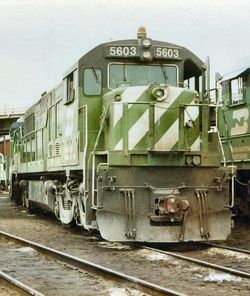| GE U25C | |||||||||||||||||||
|---|---|---|---|---|---|---|---|---|---|---|---|---|---|---|---|---|---|---|---|
 Burlington Northern Railroad U25C #5603. | |||||||||||||||||||
| |||||||||||||||||||
| |||||||||||||||||||
| |||||||||||||||||||
| |||||||||||||||||||
The U25C is a diesel locomotive built by General Electric intended for the United States domestic market. Launched in September 1963, it remained in production until December 1965. It was replaced by the U28C.
